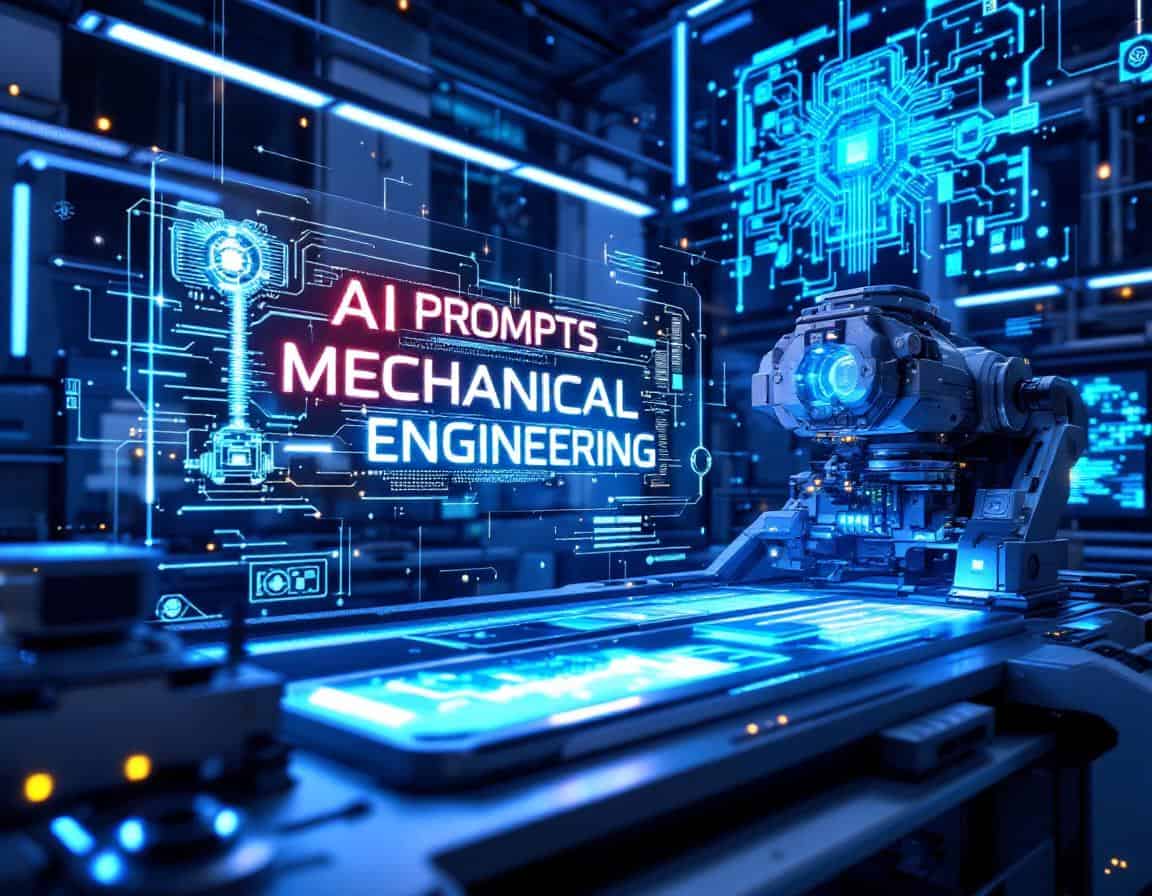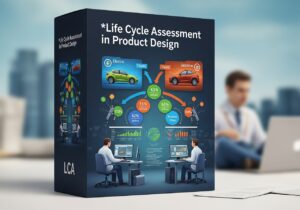
Online-KI-Tools verändern den Maschinenbau rapide, indem sie die menschlichen Fähigkeiten in den Bereichen Konstruktion und Analyse ergänzen, Herstellungund Wartung. Diese KI-Systeme können riesige Datenmengen verarbeiten, komplexe Muster erkennen und neue Lösungen viel schneller als herkömmliche Methoden entwickeln. So kann KI Sie beispielsweise bei der Optimierung von Konstruktionen im Hinblick auf Leistung und Herstellbarkeit unterstützen, komplexe Simulationen beschleunigen, Materialeigenschaften vorhersagen und eine Vielzahl von Analyseaufgaben automatisieren.
Die nachstehenden Hinweise helfen zum Beispiel bei der generativen Konstruktion, beschleunigen Simulationen (FEA/CFD), helfen bei der vorausschauenden Wartung, bei der KI Sensordaten von Maschinen analysiert, um potenzielle Ausfälle vorherzusagen, ermöglichen eine proaktive Wartung und minimieren Ausfallzeiten, helfen bei der Materialauswahl und vieles mehr.
- Diese Seite ist spezifisch für eine Domain. Bei Bedarf können Sie in unserer > Suchmaschine nach allen Domains und allen Kriterien suchen. AI Prompts Verzeichnis <, gewidmet dem Produktdesign Und Innovation.
- Angesichts der Server-Ressourcen und des Zeitaufwands sind die Eingabeaufforderungen selbst nur registrierten Mitgliedern vorbehalten und unten nicht sichtbar, wenn Sie nicht angemeldet sind. Sie können sich registrieren, 100% kostenlos:
Mitgliedschaft erforderlich
Sie müssen Mitglied sein, um auf diesen Inhalt zugreifen zu können.
- Ursachenanalyse
- Maschinenbau
AI Aufforderung an 5-Whys-Protokoll für Prozessanomalien
- 5 Warums, Kontinuierliche Verbesserung, Analyse des Versagens, Schlanke Fertigung, Maschinenbau, Problemlösungs-Techniken, Prozessverbesserung, Qualitätsmanagement, Ursachenanalyse
Führt einen Benutzer durch eine strukturierte 5-Whys-Ursachenanalyse für eine Anomalie im Fertigungsprozess im Maschinenbau. Diese Aufforderung hilft bei der Suche nach der grundlegenden Ursache, indem auf der Grundlage des ursprünglichen Problems und des Prozesskontexts iterativ nach dem Warum gefragt wird. Die Ausgabe ist ein textbasierter, strukturierter Fragepfad.
Ausgabe:
- Text
- erfordert kein Live-Internet
- Felder: {Anfangsproblem_Anweisungstext} {Prozessname_und_Kontext}
- Am besten geeignet für: Maschinenbauingenieure durch die 5-Whys-Methode zu führen, um systematisch die grundlegenden Gründe für Anomalien oder Ausfälle im Fertigungsprozess aufzudecken.
- Ethische Erwägungen und Folgenanalyse
- Maschinenbau
AI Aufforderung an Überblick über die Umweltverträglichkeitsprüfung während des gesamten Lebenszyklus
- Kreislaufwirtschaft, Umweltfreundliche Herstellung, Umweltauswirkungen, Umweltverträglichkeitsprüfung, Lebenszyklus, Ökobilanz (LCA), Nachhaltigkeitspraktiken, Nachhaltige Entwicklung, Nachhaltiges Produktdesign
Umreißt die wichtigsten Phasen und Überlegungen für die Durchführung einer Ökobilanz für ein neues mechanisches Produkt. Diese Aufforderung hilft Ingenieuren bei der Strukturierung ihrer LCA-Anstrengungen, indem sie die benötigten Daten, die Wirkungskategorien und die Möglichkeiten zur Schadensbegrenzung ermittelt. Das Ergebnis ist ein Markdown-Dokument, das den LCA-Plan detailliert beschreibt.
Ausgabe:
- Markdown
- erfordert Live-Internet
- Felder: {product_name_and_function} {bill_of_materials_csv} {manufacturing_processes_overview_text} {expected_use_phase_and_disposal_text}
- Am besten geeignet für: Strukturierung der Umweltverträglichkeitsprüfung mechanischer Produkte über den gesamten Lebenszyklus, damit Ingenieure die Umweltauswirkungen systematisch bewerten und verringern können.
- Ethische Erwägungen und Folgenanalyse
- Maschinenbau
AI Aufforderung an Analyse der gesellschaftlichen Auswirkungen der Automatisierung
- Änderungsmanagement, Industrielle Automatisierung, Maschinenbau, Nachhaltigkeitspraktiken
Analysiert die potenziellen gesellschaftlichen Auswirkungen, wie z. B. Beschäftigungsverschiebungen, Veränderungen der Qualifikationsnachfrage und Fragen der Zugänglichkeit, die sich aus der Einführung einer bestimmten Automatisierungstechnologie in einem Maschinenbausektor ergeben. Diese Aufforderung hilft den Ingenieuren, weitergehende gesellschaftliche Konsequenzen zu berücksichtigen. Das Ergebnis ist ein textbasierter Bericht.
Ausgabe:
- Text
- erfordert Live-Internet
- Felder: {automation_technology_description} {industry_sector_of_application} {geographical_region_context}
- Am besten geeignet für: Analyse potenzieller gesellschaftlicher Folgen der Automatisierung im Maschinenbau, wie z. B. Beschäftigungsverlagerungen und Qualifikationsbedarf, als Grundlage für eine verantwortungsvolle Technologieeinführung.
- Ethische Erwägungen und Folgenanalyse
- Maschinenbau
AI Aufforderung an Ethische Bewertung der Dual-Use-Technologie
- Additive Fertigung, Design für additive Fertigung (DfAM), Umweltauswirkungen, Maschinenbau, Risikomanagement, Nachhaltigkeitspraktiken
Führt eine vorläufige ethische Bewertung für eine Maschinentechnologie durch, die möglicherweise für Anwendungen mit doppeltem Verwendungszweck geeignet ist, und hebt dabei mögliche Risiken und ethische Dilemmata hervor und schlägt Schutzmaßnahmen vor. Diese Aufforderung zielt darauf ab, eine verantwortungsvolle Innovation zu fördern, indem unbeabsichtigte Folgen berücksichtigt werden. Das Ergebnis ist ein strukturierter Markdown-Bericht.
Ausgabe:
- Markdown
- erfordert kein Live-Internet
- Felder: {technology_description_and_capabilities} {intended_civilian_application} {potential_misuse_concerns_list_csv}
- Am besten geeignet für: Bewertung mechanischer Technologien mit doppeltem Verwendungszweck im Hinblick auf ethische Risiken und Missbrauchspotenzial, Anleitung von Ingenieuren zu verantwortungsvoller Innovation und Vorschlag von Schutzmaßnahmen.
- Optimierung der Versuchsplanung
- Maschinenbau
AI Aufforderung an Kritik am Versuchsplan und Verbesserungsvorschläge
- Entwurfsanalyse, Bewertung des Designs, Optimierung des Designs, Prozessverbesserung, Qualitätssicherung, Qualitätskontrolle, Statistische Analyse, Validierung
Diese Aufforderung fordert die KI auf, einen vorgegebenen Versuchsplan im Maschinenbau zu analysieren, Schwachstellen zu identifizieren und detaillierte Verbesserungen vorzuschlagen, um Validität, Zuverlässigkeit und Effizienz zu verbessern. Der Benutzer gibt die Beschreibung des Versuchsplans und die Schlüsselvariablen ein.
Ausgabe:
- Text
- erfordert kein Live-Internet
- Felder: {experimenteller_plan} {Schlüssel_Variablen}
- Am besten geeignet für: Am besten geeignet für die Optimierung von Versuchsaufbauten, um zuverlässigere und validere Ergebnisse zu erzielen
- Unterstützung beim Verfassen von Finanzhilfeanträgen und wissenschaftlichen Arbeiten
- Maschinenbau
AI Aufforderung an Entwurf des Abschnitts über die Bedeutung von Finanzhilfevorschlägen
- Additive Fertigung, Design für additive Fertigung (DfAM), Innovation, Maschinenbau, Produktentwicklung, Prototyping, Forschung und Entwicklung, Nachhaltigkeitspraktiken, Wert-Angebot
Entwirft die Abschnitte "Bedeutung" und "Innovation" für einen Förderantrag im Bereich Maschinenbau und hebt die Neuheit des Projekts, die Forschungslücke und die potenziellen Auswirkungen hervor. Diese Aufforderung hilft Ingenieuren, den Kernwert ihrer vorgeschlagenen Arbeit zu formulieren. Die Ausgabe ist ein mit Markdown formatierter Text.
Ausgabe:
- Markdown
- erfordert kein Live-Internet
- Felder: {project_title} {Forschungs_Problem_Aussage} {vorgeschlagene_Lösung_Zusammenfassung} {Schlüssel_innovative_Aspekte_liste_csv}
- Ideal für: Unterstützung von Maschinenbauingenieuren bei der Abfassung überzeugender Abschnitte über Bedeutung und Innovation für Förderanträge, um den Wert und die Neuartigkeit der Forschung klar zu formulieren.
- Optimierung der Versuchsplanung
- Maschinenbau
AI Aufforderung an Generator für optimale Versuchsplanung
- Design für additive Fertigung (DfAM), Design für die Fertigung (DfM), Maschinenbau, Prozess-Optimierung, Qualitätssicherung, Qualitätskontrolle, Forschung und Entwicklung, Statistische Analyse
Diese Eingabeaufforderung weist die KI an, ein optimales Experiment zu entwerfen, um bestimmte Parameter des Maschinenbaus zu untersuchen. Der Benutzer gibt die Forschungsfrage, die zu prüfenden Variablen und die Beschränkungen an. Die KI gibt einen vollständigen Versuchsplan mit Kontrollgruppen, Stichprobengrößen und Messstrategien zurück.
Ausgabe:
- Markdown
- erfordert kein Live-Internet
- Felder: {Forschungsfrage} {Variablen} {Einschränkungen}
- Am besten geeignet für: Am besten für die Erstellung umfassender, statistisch fundierter Experimente im Maschinenbau
- Unterstützung beim Verfassen von Finanzhilfeanträgen und wissenschaftlichen Arbeiten
- Maschinenbau
AI Aufforderung an Generator für die Zusammenfassung technischer Berichte
- Kontinuierliche Verbesserung, Design für additive Fertigung (DfAM), Maschinenbau, Methodik, Prozessverbesserung, Projektmanagement, Qualitätsmanagement, Forschung und Entwicklung, Nachhaltigkeitspraktiken
Erzeugt eine prägnante und informative Zusammenfassung für einen technischen Bericht auf der Grundlage der wichtigsten Abschnitte des Berichts. Diese Eingabeaufforderung hilft Ingenieuren, ihre Arbeit schnell zusammenzufassen, um sie weiter zu verbreiten. Die Ausgabe ist eine einfache Textzusammenfassung.
Ausgabe:
- Text
- erfordert kein Live-Internet
- Felder: {Bericht_Titel} {project_objectives_summary} {methodologie_verwendet_zusammenfassung} {Schlüssel_Ergebnisse_und_Schlussfolgerungen_Zusammenfassung}
- Ideal für: Erstellung prägnanter und gut strukturierter Zusammenfassungen für technische Berichte, die Maschinenbauern helfen, Projektziele, Methoden, Ergebnisse und Schlussfolgerungen effizient zusammenzufassen.
- Optimierung der Versuchsplanung
- Maschinenbau
AI Aufforderung an Statistische Leistungsanalyse für Experimente
- Entwurf für Six Sigma (DfSS), Prozessverbesserung, Prozess-Optimierung, Qualitätssicherung, Qualitätskontrolle, Statistische Analyse, Statistische Prozesskontrolle (SPC), Statistische Tests, Validierung
Diese Aufforderung fordert die KI auf, eine statistische Power-Analyse für ein Maschinenbauexperiment auf der Grundlage von Eingabeparametern wie Effektgröße, Stichprobengröße und Signifikanzniveau durchzuführen. Sie hilft festzustellen, ob das Experiment ausreichend leistungsfähig ist.
Ausgabe:
- Text
- erfordert kein Live-Internet
- Felder: {effect_size} {sample_size} {significance_level}
- Am besten geeignet für: Am besten geeignet für die Validierung von Versuchsplänen durch Leistungsberechnungen
- Unterstützung beim Verfassen von Finanzhilfeanträgen und wissenschaftlichen Arbeiten
- Maschinenbau
AI Aufforderung an Forschungspapier Methodologiekritik
- Design für additive Fertigung (DfAM), Maschinenbau, Methodik, Prozessverbesserung, Qualitätssicherung, Qualitätskontrolle, Forschung und Entwicklung, Statistische Analyse, Validierung
Überprüft und schlägt Verbesserungen für den Methodikteil einer Forschungsarbeit im Maschinenbau vor, wobei der Schwerpunkt auf der Klarheit, Vollständigkeit, Rechtfertigung und Angemessenheit der verwendeten Methoden liegt. Diese Aufforderung trägt dazu bei, die Strenge und Reproduzierbarkeit der Forschung zu verbessern. Das Ergebnis ist eine im Markdown-Format erstellte Kritik.
Ausgabe:
- Markdown
- erfordert kein Live-Internet
- Felder: {aktuelle_methodologie_abschnitt_text} {Forschungs_Zielsetzung_text} {Schlüssel_Ausrüstung_oder_Software_verwendet_liste_csv}
- Am besten geeignet für: Detaillierte konstruktive Kritik an den methodischen Abschnitten von Forschungsarbeiten, um Maschinenbauingenieuren zu helfen, die Klarheit, Strenge und Reproduzierbarkeit ihrer Arbeit zu verbessern.



























Gehen wir davon aus, dass KI im Maschinenbau immer die besten Prompts generieren kann? Wie werden diese im Übrigen generiert?
Wird die KI menschliche Ingenieure überflüssig machen?
Verwandte Artikel
Greenwashing: Die 15 besten Tipps eines Gentlemans zur exquisiten Täuschung
So bekämpfen Sie am besten ein angemeldetes Patent
Alle Patentstatus: PCT vs. angemeldetes Patent vs. veröffentlichtes Patent vs. erteiltes Patent
Die 10 besten Strategien und Tools zur Patentnichtigkeit
Ökobilanz (LCA) im Produktdesign
Übersicht zur Produktwertanalyse